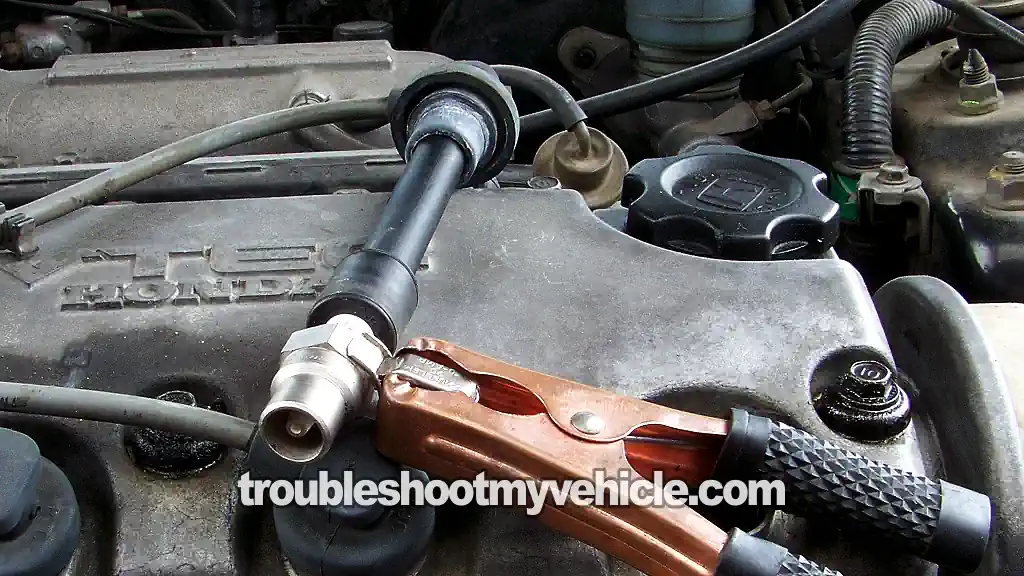
The thing that complicates troubleshooting a misfire condition on your 1995-2000 Honda 1.6L equipped Civic (Civic Del Sol) is that the root cause could lie in failed spark plug wires, or a bad distributor cap, or a bad fuel injector, or in one engine cylinder having very low compression, etc.
I could go on about more 'possible' bad components, which could make you think that diagnosing a misfire (rough idle) can seem quite impossible.
The good news is that testing a misfire code, or misfire codes, or a rough idle condition is not that hard and it's something you can do!
In this tutorial, I'm going to explain in some detail the most common causes of misfires and misfire codes (P0300, P0301, P0302, P0303, P0304 -OBD II equipped Civics) and more importantly, I'm also gonna' offer you a simple diagnostic strategy that I'm certain will help you 'nail down' the cause of the misfire condition, misfire code, or rough idle condition your Honda is experiencing.
Contents of this tutorial:
ES ![]() You can find this tutorial in Spanish here: Cómo Probar Una Falla En Cilindro (1995-2000 1.6L Honda Civic) (at: autotecnico-online.com).
You can find this tutorial in Spanish here: Cómo Probar Una Falla En Cilindro (1995-2000 1.6L Honda Civic) (at: autotecnico-online.com).
APPLIES TO: This tutorial applies to the following vehicles:
- 1.6L Honda Civic: 1995, 1996, 1997, 1998, 1999, 2000.
- 1.6L Honda Civic Del Sol: 1994, 1995, 1996, 1997.
What Is A Misfire Condition?
In plain English, a misfiring cylinder is a cylinder that's 'dead', either because it's missing fuel, or spark, or air.
Since the engine in your 1.6L Honda Civic (Civic Del Sol) has only 4 cylinders, having just one 'dead' cylinder will wreak havoc with the engine's idle and performance. If the engine has two misfiring cylinders, it's not gonna' start and run.
Here are a few other symptoms you'll see with a misfire:
- The Check Engine Light will be on.
- One or more misfire codes (P0300-P0304) will be stored in your Civic's PCM memory (if OBD II equipped).
- P0300 Random Cylinder Misfire.
- P0301 Cylinder #1 Misfire.
- P0302 Cylinder #2 Misfire.
- P0303 Cylinder #3 Misfire.
- P0304 Cylinder #4 Misfire.
- Sometimes, even tho' your OBD II equipped Civic is suffering a bonafide misfire, no misfire codes are registered and no Check Engine Light (CEL) comes on.
- Lack of power upon acceleration.
- Smell of unburned gas exiting the tail pipe.
- Rough idle and may stall.
- Cranks but does not start.
- Will not pass the emissions tests.
- Bad gas mileage.
Although the misfire codes don't tell you what exactly is the cause of the misfire or rough idle condition, there is a way to find out exactly what is causing it.
One of the most important things you need to know, to successfully diagnose a misfire or rough idle condition, is what causes a misfire. Let's go to the next subheading and find out.
What Causes A Misfire Condition?
As I mentioned earlier, every cylinder in your Civic's engine needs three essential things: air, fuel, and spark to produce power. A misfire happens when any one of those three is missing from the mix. Let's look into more specifics:
Ignition System: The ignition system is responsible for the production and delivery of spark. The ignition system is usually the culprit behind most misfires.
The usual suspects (that cause a misfire) are:
- Bad spark plugs.
- Bad spark plug wires (high tension wires).
- Carbon tracks on the spark plug and spark plug boot.
- Bad distributor cap.
- Oil dripping (from the valve cover) onto the spark plugs and spark plug boots.
Fuel System: The fuel system is responsible for the delivery of fuel. If fuel is missing from any one specific engine cylinder, it will misfire.
Fuel system problems could include some of the following:
- Bad fuel injectors (multi-port fuel-injected Civics).
- Broken fuel injector connector (this is a very, very common problem).
- Electrical short in the fuel injector wires that are keeping the fuel injector pulse signal from reaching the fuel injector.
- This is usually the result of human error and after a major mechanical repair where the wiring harness was damaged.
- Bad fuel injection computer not pulsing the fuel injector (this is a very rare condition, but it happens).
- Bad fuel pump.
Engine Mechanical Condition: The pistons and cylinder head valves are the ones that draw air into the engine. Usually all cylinders wear out evenly, but every now and then, either thru' lack of maintenance or some mechanical problem, you'll have one or more wear out at an accelerated pace.
To make the long story short, those cylinders (with accelerated wear and tear) to produce a less than average compression value that will cause a misfire condition.
Other issues, that can not be overlooked are vacuum leaks.
What Tests Can I Perform To Find The Cause Of The Misfire Condition?

Now that you're aware that the root cause of a misfire (or a 'dead' cylinder) is a lack of fuel, or spark or air, so you might be asking yourself, 'What do I start testing first?'.
In this section, I'm gonna' offer you a simple diagnostic strategy that should help you find and resolve the root cause of the misfire or 'dead' cylinder on your 1.6L Honda Civic.
STEP 1: Identify the dead cylinder. Since your Honda Civic is OBD II equipped, this is usually means reading the misfire diagnostic trouble codes with a scan tool. Then by matching the misfire code to its engine cylinder using an illustration of the engine cylinders.
In many cases, the PCM does not give you any misfire codes, even though the engine is suffering a bonafide misfire. In these cases and if your Honda Civic has multi-port fuel injection (one injector per cylinder), you'll need to do a manual cylinder balance test by unplugging one fuel injector at a time (to see which one has NO effect on the engine's idle).
- The following tutorial will explain in-depth how to do a manual cylinder balance test (if you Honda has multi-port fuel injection):
The fuel injector that does not worsen the engine's idle when unplugged tells you that that specific cylinder is 'dead'.
If your Civic (or Civic Del Sol) does not have multi-port fuel injection and/or OBD II, I recommend you start by testing the ignition system first (see STEP 2).
STEP 2: Test the ignition system . Since the majority of misfires are caused by a failed component in the ignition system, it's important to make sure that the misfiring cylinder is getting spark. You should:
- Perform a spark test (using a dedicated spark tester) on the spark plug wire of the cylinder that the misfire code is accusing of being dead.
- Testing for spark with a spark tester is the most important first test, since you'll know right away if the misfire is due to a lack of spark.
- Check to see if the spark plug boots and spark plugs are swimming in engine oil from a leaking valve cover gasket.
- If you got spark from your spark tester (from the cylinder the misfire code is accusing of misfiring), the next step is to remove the spark plug or spark plugs (of the affected cylinders) and check them for wear and tear, carbon tracks, anti-freeze, etc.
- If you get no spark, then the next step is to check for spark directly on the ignition coil tower (the ignition coil is inside the distributor).
- You can find all of these ignition system tests here:
- How To Test The Igniter, Ignition Coil Accord, Civic, CRV, and Odyssey (at: easyautodiagnostics.com).
- Carbon Tracks Are A Common Cause Of Ignition Misfires (at: easyautodiagnostics.com).
STEP 3: Test the fuel injectors. If the ignition system is not the cause of the misfire, then the next step is to check the fuel injectors (this section applies to the multi-port fuel-injected Civics).
You'll need to:
- Resistance test each of the 4 fuel injectors.
- Do a Noid light test of each one to make sure the PCM is pulsing them (activating them).
- You can find the fuel injector tests here:
STEP 4: Test the compression of each engine cylinder. Other tests that should be done, if the ignition system and fuel injectors check out OK are:
- Engine compression test.
- Checking for vacuum leaks.
- You can find the engine compression test here: How To Test Engine Compression (1995-2000 1.6L Honda Civic).
The above list of steps may seem/sound like troubleshooting a Misfire is a complicated thing but it really isn't. Depending on your level of 'wrenching' experience, this is something that you can accomplish without taking it to the shop.
What Tools Do I Need To Test The Misfire Code(s)?
Finding the exact cause of the misfire codes or misfire condition is possible with the proper tools. Without them, you won't be able to diagnose/troubleshoot those issues on your 1.6L Honda Civic.
Depending on what the root cause of the misfire is, you may need several tools. Most of these you can buy online, none of these will break the bank and I'll make some recommendations on them. Here's a guide to some of the basic tools that can be and are used:
- Ignition System Tests:
- Spark Tester.
- Multimeter.
- Test Light.
- Fuel System Tests:
- Noid Light.
- Fuel Pressure Gauge.
- Multimeter.
- Engine Mechanical Tests:
- Compression Tester.
Now of course, you'll also need basic hand tools like: screw-drivers, ratchet wrenches, sockets, etc. You'll also need a generic scan tool to retrieve the diagnostic trouble codes (DTCs) from the computer's memory (if OBD II equipped).
Keep in mind that using the right tool for the job will save you time, frustration, and /or keep you from damaging the component that you're testing.
More 1.6L Honda Civic Tutorials
You can find a complete list of 1.6L Honda Civic tutorials in this index:
Here's a small sample of the tutorials you'll find in the index:
- How To Test For A Blown Head Gasket (1995-2000 1.6L Honda Civic).
- How To Test The Alternator (1996-2000 1.6L Honda Civic).
- Testing Shift Control Solenoid Valves A and B (1996-2000 1.6L Honda Civic).
- How To Troubleshoot A No Start (1995-2000 1.6L Honda Civic).
- How To Test The Igniter, Ignition Coil Accord, Civic, CRV, and Odyssey (at: easyautodiagnostics.com).

If this info saved the day, buy me a beer!


